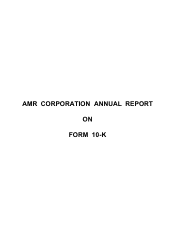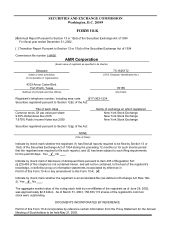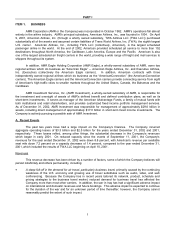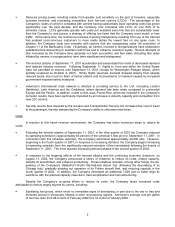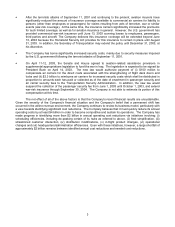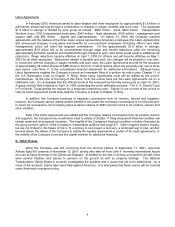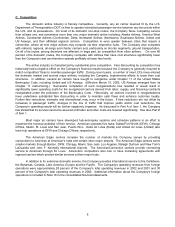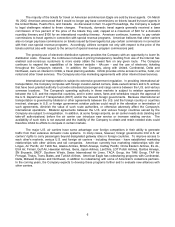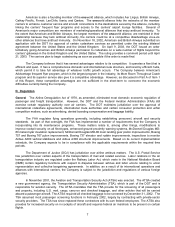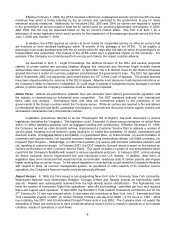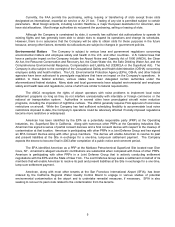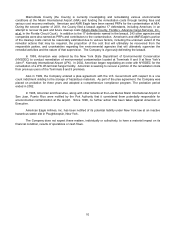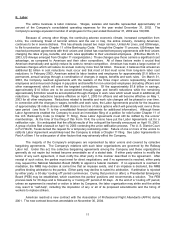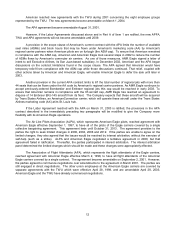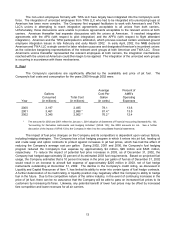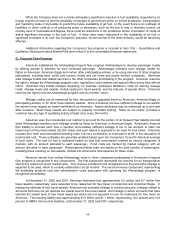American Airlines 2002 Annual Report Download - page 6
Download and view the complete annual report
Please find page 6 of the 2002 American Airlines annual report below. You can navigate through the pages in the report by either clicking on the pages listed below, or by using the keyword search tool below to find specific information within the annual report.
4
Labor Agreements
In February 2003, American asked its labor leaders and other employees for approximately $1.8 billion in
permanent, annual savings through a combination of changes in wages, benefits and work rules. The requested
$1.8 billion in savings is divided by work group as follows: $660 million - pilots, $620 million - Transportation
Workers Union (TWU) represented employees, $340 million - flight attendants, $100 million - management and
support staff, and $80 million - agents and representatives. On March 31, 2003, the Company reached
agreements with the leaders of the three major unions representing American employees (the Labor Agreements)
and announced changes in pay plans and benefits for non-unionized employees (including officers and other
management) which will meet the targeted contributions. Of the approximately $1.8 billion in savings,
approximately $1.0 billion are to be accomplished through wage and benefit reductions while the remaining
approximately $.8 billion would be accomplished through changes in work rules which would result in additional job
reductions. Wage reductions became effective on April 1, 2003 for officers and will become effective on May 1,
2003 for all other employees. Reductions related to benefits and work rule changes will be phased in over time.
In connection with the changes in wages, benefits and work rules, the Labor Agreements provide for the issuance
of approximately 38 million shares of AMR stock in the form of stock options which will generally vest over a three
year period (see Note 11 to the consolidated financial statements for additional information). Although these
Labor Agreements enabled the Company to avoid an immediate filing of a petition for relief under Chapter 11 of
the U.S. Bankruptcy Code (a Chapter 11 filing), these Labor Agreements must still be ratified by the unions’
memberships. At the time of the filing of this Form 10-K, the unions have put the Labor Agreements out for a
ratification vote. It is anticipated that the official results of the voting will be formally announced on April 15, 2003.
A group of pilots filed a lawsuit on April 14, 2003 contesting the union ratification process. The U. S. District Court
in Fort Worth, Texas denied the request for a temporary restraining order. Failure of one or more of the unions to
ratify its Labor Agreement would likely lead the Company to initiate a Chapter 11 filing.
In addition, the Company continues to negotiate concessions from its vendors, lessors and suppliers;
however, the Company cannot reliably predict whether it will obtain the necessary concessions or for what amount.
In return for concessions, the Company plans to deliver shares of AMR common stock to its vendors, lessors and
other creditors.
Even if the Labor Agreements are ratified and the Company obtains concessions from its vendors, lessors
and suppliers, the Company may nonetheless need to initiate a Chapter 11 filing because its financial condition will
remain weak and its prospects uncertain. The fragility of the Company’s financial condition is further illustrated by
the going concern opinion of the Company’s independent auditors (see page 47). Other negative factors include,
but are not limited to, the failure of the U. S. economy to soon begin a recovery, a prolonged war in Iraq, another
terrorist attack, the failure of the Company to satisfy the liquidity requirement in certain of its credit agreements, or
the inability of the Company to access the capital markets for additional financing.
B. Other Events
While the Company was still recovering from the terrorist attacks of September 11, 2001, American
Airlines flight 587 crashed on November 12, 2001, shortly after take-off from John F. Kennedy International Airport
en route to Santo Domingo in the Dominican Republic. In addition to the loss of all lives on board the aircraft, there
were several fatalities and injuries to persons on the ground as well as property damage. The National
Transportation Safety Board is currently investigating the accident and a cause has yet to be determined. As a
result of the accident, claims have been filed against American. It is anticipated that these claims will be covered
under American’s insurance policy.

